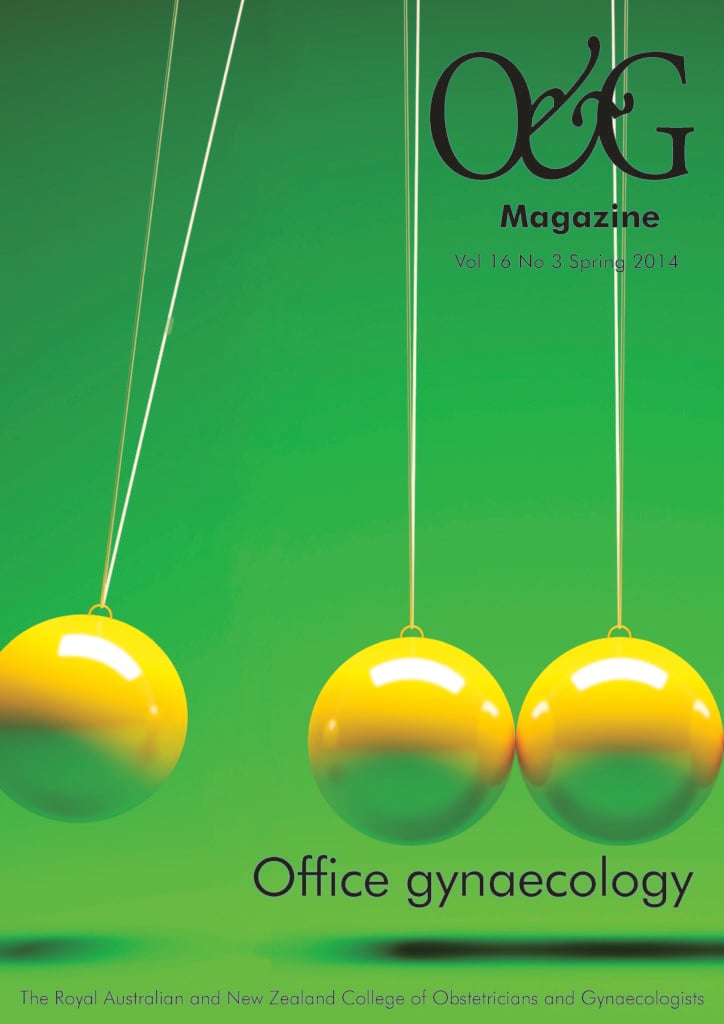How much can be achieved in the office setting before referring to a specialist with an interest in this field?
Vulval pain as a presenting complaint is frequently frustrating for both patient and practitioner, owing to the difficulties in both identifying the cause of the pain and treating it. Many practitioners may not feel confident in managing this condition and patients have often seen many health professionals as they have been dissatisfied with their care.1
The prevalence of vulval pain in the Australasian population is currently unknown. A large study in a US population found a lifetime incidence rate of up to 16 per cent.1 It is an important issue to address as it has been found, unsurprisingly, women with vulval pain report significantly lower quality of life, higher levels of distress related to sexual activities and lower levels of happiness in relationships than those without pain.2 The type of vulval pain and symptoms can vary, but is often described as burning, stinging or itching. It is also important to address causes of acute vulval pain early as many of these are easily treatable (infection, contact dermatitis, other dermatoses) and early treatment may prevent the development of some forms of chronic vulval pain.
Classification
Many classifications have been used to try to describe and diagnose vulval pain. The International Society for the Study of Vulvovaginal Disease (ISSVD) introduced a classification framework in 2003 that is used by many specialists in vulval care (see Box 1).3
The specific disorder(s) causing vulval pain, once identified, often have an easy path of treatment to follow and may be managed by primary caregivers alone. Vulvodynia (typically described as burning pain) occurs in the absence of relevant clinical findings or a specific clinically identifiable neurologic disorder. If vulvodynia is identified, a multidisciplinary approach to treatment will improve outcomes for the patient.4
History
When taking a history of vulval pain, it is essential for the practitioner to build rapport with the patient. As very few causes of chronic vulval pain have a quick-fix solution, it is likely that the initial appointment is the first of many. A thorough history is vital in determining the potential cause of the pain. Both indirect (allowing the patient to tell their story) and direct questioning to clarify points is required.
Apart from the normal questions that comprise a pain history (type, frequency, duration, triggers and relievers), there are points specific to vulval pain that may help to differentiate the cause. These include:
- Pain with or after sex: superficial (‘vestibulodynia’, vulval dermatoses, levator ani hypertonicity, vaginismus, pudendal nerve neuralgia), deep (endometriosis, pudendal nerve neuralgia).
- History of dermatological conditions: allergic dermatitis, psoriasis, lichen planus.
- Medications: antibiotics (can predispose to recurrent candidiasis).
- Vaginal discharge: white (candidiasis, bacterial vaginosis [BV]), yellow (desquamative inflammatory vaginitis, sexually transmitted infections [STI], lichen planus, atrophic vaginitis), postcoital bleeding (STI, human papilloma virus causing cervical intraepithelial neoplasia [CIN] with or without vulval intraepithelial neoplasia [VIN]).
- Other pain syndromes: chronic pelvic pain, irritable bowel syndrome, painful bladder syndrome, endometriosis, fibromyalgia.5
- Trauma: obstetric trauma (prolonged second stage, instrumental or perineal injury may lead to pudendal nerve neuralgia or a neuroma), female genital mutilation.
- Low oestrogenic state: peri- or postmenopausal age or breastfeeding can result in pain from atrophic changes.
A vulval pain index similar to those existing for chronic pain is yet to be developed. However, the ISSVD website contains an extensive questionnaire to assist history taking and examination.
Examination
A thorough examination of the urogenital system is required. The external genitalia should be closely inspected for any lesions, scars, anatomical variations and structural changes.
A sensory examination (the Q-tip test) can help differentiate between generalised or localised provoked vulvodynia. A cotton bud is used to gently palpate the labia majora, perineum, clitoral hood, Skene’s glands, labial sulci and labia minora. Neuropathic processes, infection, dermatoses or generalised vulvodynia may contribute to pain in any of these areas. Then palpate around the vestibule in clockwise direction using the cotton bud, which may elicit a pain response inconsistent with the pressure applied (localised vulvodynia).
Box 1. Classification of vulval pain (ISSVD 2003)
Vulval pain related to a specific disorder
- Infectious (candidiasis, herpes)
- Inflammatory (lichen planus, lichen sclerosus, contact dermatitis)
- Neoplastic (VIN, squamous cell carcinoma)
- Neurologic (herpes neuralgia, nerve compression)
Vulvodynia
- Generalised
- Provoked (sexual, nonsexual, or both)
- Unprovoked
Mixed (provoked and unprovoked)
- Localised (eg vestibulodynia, clitorodynia, hemivulvodynia)
- Provoked (sexual, nonsexual or both)
- Unprovoked
- Mixed (provoked and unprovoked)
Speculum examination (if the patient can tolerate this) is also important to look for normal vaginal architecture (atrophy, erythema, erosions) and discharge. The cervix should also be assessed (Pap smear and STI screening performed as needed). Bimanual examination is performed for adnexal masses, nodules of endometriosis, levator ani muscle hypertonicity or tenderness, tenderness of the pudendal nerve near the ischial spine and along the pudendal canal.
Vulvoscopy (examination of the vulva with colposcope) is extremely useful in detecting subtle changes in architecture that may enable differentiation between dermatoses.
The focus of the examination is the external genitalia, but it is also important to examine other parts of the body. These include the scalp, extensor surfaces, natal cleft and buccal mucosa for various dermatoses (lichen planus, psoriasis).
Investigations
As always, the investigations of vulval pain are dictated by the findings on history and examination. Ensuring basic screening is up to date (Pap smear and STI screening) is a simple starting point. A vaginal microbial swab may show candida species or BV. A history of intermittent or cyclical pruritus may be a result of recurrent candidiasis. The suspicion of recurrent candidiasis must be confirmed with microscopy. Identification of the candida species (albicans, glabrata, krusei, tropicalis) is important to determine if treatment is necessary. Many species other than C. albicans are less responsive to antifungal therapies and there is much debate as to whether other species contribute to a symptomatic picture.
If vulval lesions are present, perform a viral swab to identify herpes simplex virus. Consider performing a vulval biopsy (4mm punch biopsy under local anaesthetic) if the lesion has an atypical appearance. VIN has a greatly varied presentation and any lesion that doesn’t respond appropriately to treatment should be biopsied to exclude this diagnosis.
If there is a suspicion of concurrent pelvic pathology, an ultrasound scan of the pelvis is useful. Also, consider patch testing to determine the allergen contributing to vulval contact dermatitis if this is not apparent from the clinical picture.
Treatment
All patients should be educated in vulval hygiene. This includes: washing with water only or non-irritant cleansers; avoidance of potential irritants (soaps, creams, powders); and using cotton-based underwear or sanitary products. If avoidance of irritants is not possible (for instance, urinary incontinence or frequent sanitary pad use), introduce the regular use of a barrier to the vulva such as petroleum jelly. Use of lubricant (of which there are many) for sexual intercourse may also help patients with atrophy or provoked vulvodynia.
Infective causes should be treated with appropriate antimicrobials. Candidiasis should respond to a seven-day topical regimen or single dose oral preparation. Recurrent candidiasis requires a long-term eradication regimen of oral antifungal therapy (for example, 150–300mg fluconazole weekly for three-to-six months).
Many dermatoses (for example, contact or allergic dermatitis, lichen planus or lichen sclerosus) are primarily treated with topical steroids, such as Diprosone OV ointment, nightly until symptoms improve usually one-to-four weeks and then maintenance treatment as required. If there is a poor response to primary treatment, referral to a vulval specialist should be considered.
Long-standing vulval pain is likely to require a multidisciplinary treatment approach. However, an initial trial of treatment may form part of your diagnosis and provide your patient with some relief of symptoms. Topical treatments to consider include: local anaesthetic ointment (such as lignocaine five per cent) or compounded topical treatments of other neuropathic medications (for example, amitriptyline). Systemic treatment with neuropathic pain medications (such as amitriptyline, pregabalin) have been shown to be a useful adjunct to other forms of therapy.6 Surgery is rarely a treatment in managing vulval pain issues and is only suitable for carefully selected patients. If considered, a specialist with experience in the surgical management of vulval pain should be consulted.
A physiotherapist will be able to contribute with assessment of the pelvic floor and education in relaxation exercises in the case of levator ani hypertonicity or possible pudendal nerve entrapment. There is growing evidence that psychotherapy and behavioural therapy play a critical role in managing complex vulval pain.7 Referral to a chronic pain unit may allow easier access to the many facets of the multidisciplinary care required.
The management of vulval pain may seem a daunting task, but a few simple measures may produce satisfying results for many patients.
Acknowledgement
The author would like to thank Dr Ann Olsson (FRANZCOG) for her invaluable teaching over the years working at her Vulval Clinic at the Royal Adelaide Hospital and the Adelaide Women’s Health Centre. I, along with many other registrars, have been fortunate to learn from her and I hope many more will also have the same opportunity.
References
- Harlow BL et al. A population-based assessment of chronic unexplained vulvar pain: have we underestimated the prevalence of vulvodynia? J Am Med Women’s Assoc 2003;58:82-88.
- Sargeant HA and O’Callaghan FV. The impact of chronic vulval pain on quality of life and psychosocial well-being. ANZJOG 2007;47:235- 239.
- Moyal-Baracco M, Lynch PJ. 2003 ISSVD terminology and classification of vulvodynia: A historical perspective. J Reprod Med 2004;49:772-7.
- Munday P, Buchan A, Ravenhill G, Wiggs A, Brooks F. A qualitative study of women with vulvodynia: II. Response to a multidisciplinary approach to management. J Reprod Med 2007;52:19-22.
- Reed BD1, Harlow SD, Sen A, Edwards RM, Chen D, Haefner HK. Relationship between vulvodynia and chronic comorbid pain conditions. Obstet Gynecol 2012;120(1):145-51.
- Harris G, Horowitz B, Borgida A. Evaluation of gabapentin in the treatment of generalized vulvodynia, unprovoked. J Reprod Med 2007;52:103-
- Bergeron S, Khalife S, Glazer HI, Binik YM. Surgical and behavioural treatments for vestibulodynia: two-and-one-half-year follow-up and predictors of outcome. Obstet Gynecol 2008;111:159-66.
- Goldstein AT, Pukall CF, Goldstein I, editors. Female sexual pain disorders: evaluation and management. 1st ed. West Sussex (UK): Blackwell Publishing; 2009.
Resources
The Australian and New Zealand Vulvovaginal Society (ANZVS) website contains patient handouts, opportunities for further training and meetings. www.anzvs.org . The ISSVD website also contains patient information and practitioner references: www.issvd.org . The site www.caredownthere.com.au is an informative patient resource.





Leave a Reply